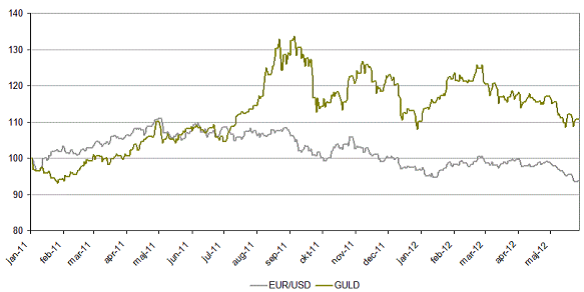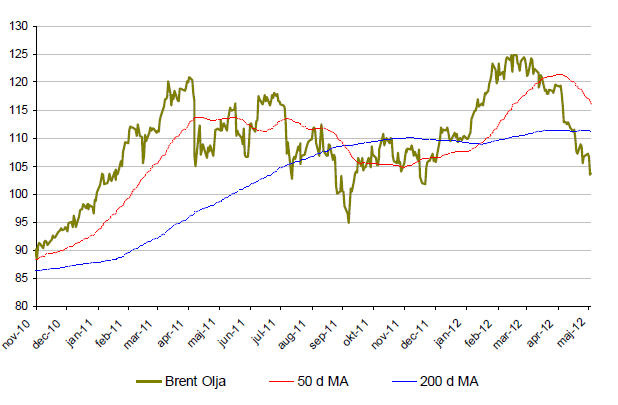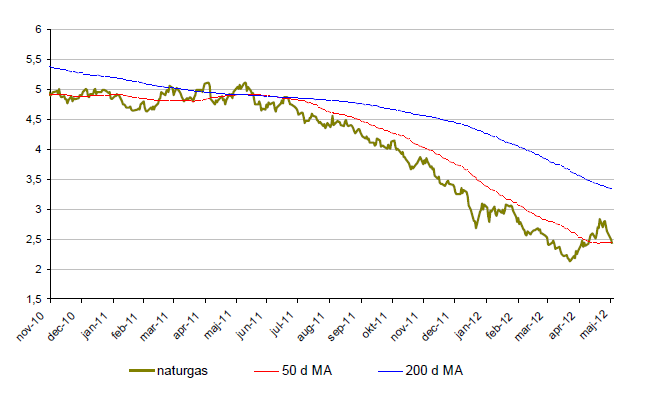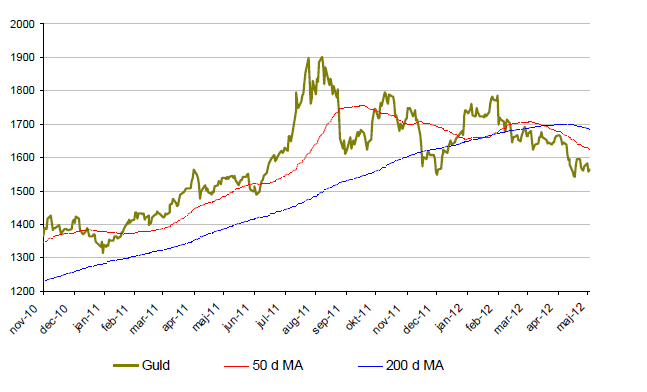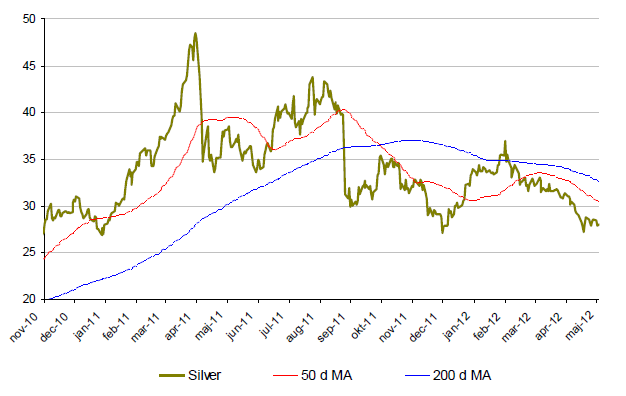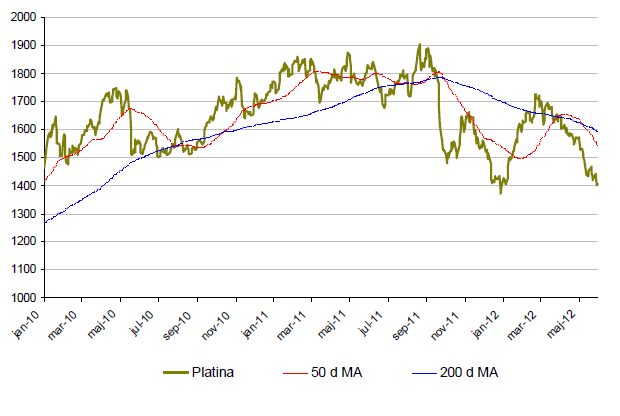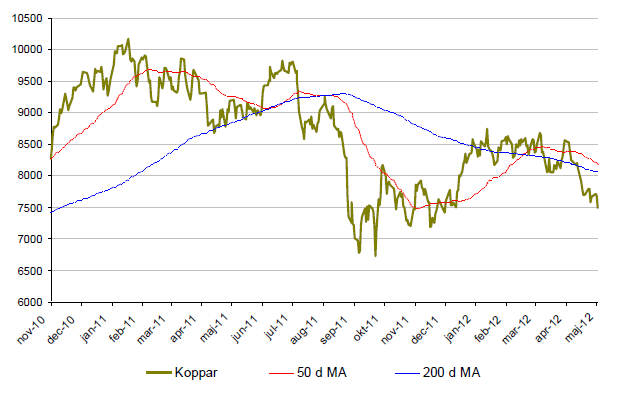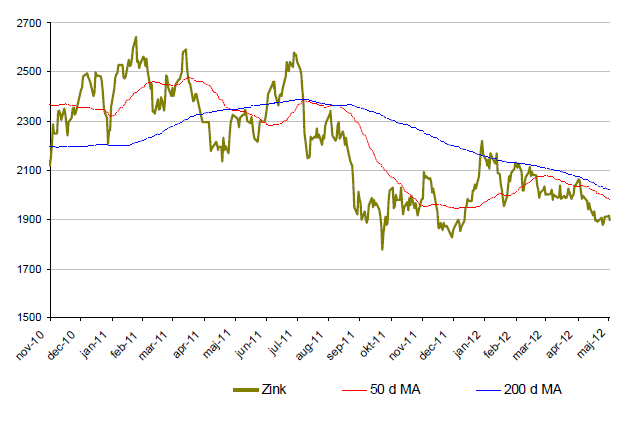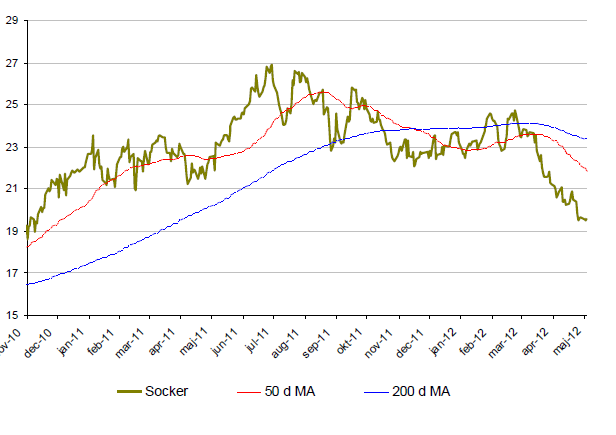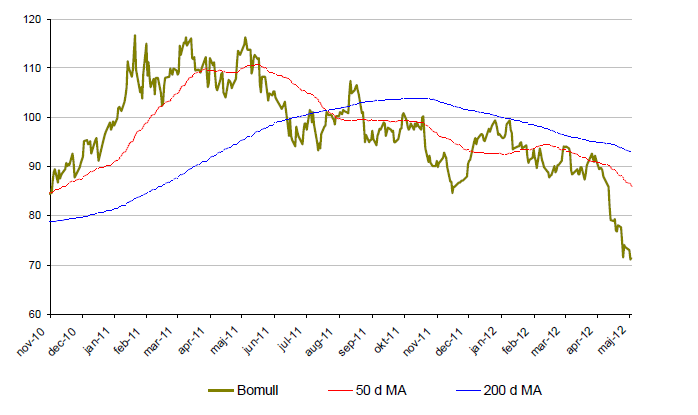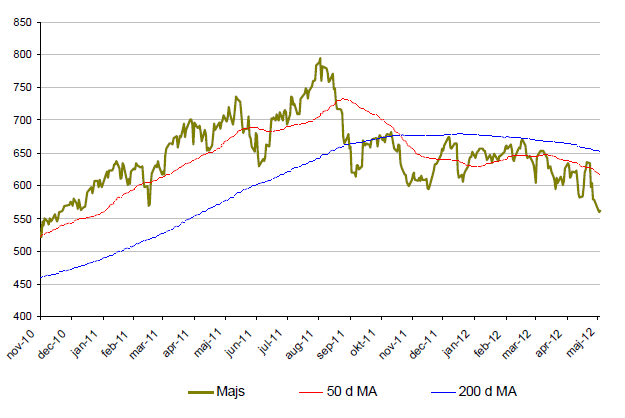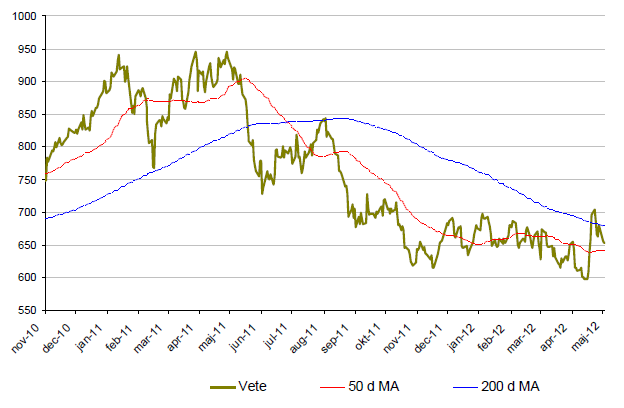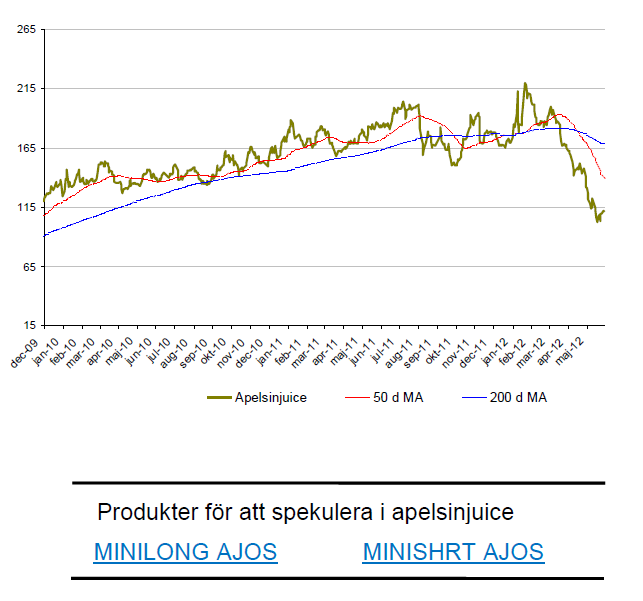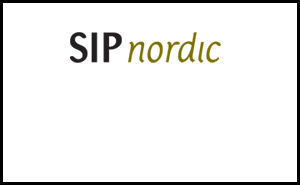Analys
SIP Nordic – Råvaruguiden – juni 2012
 Råvaror och Grexit
Råvaror och Grexit
Det spekuleras vilt i medierna om ett potentiellt Grekiskt utträde ur EU, även kallat Grexit. Det debatteras fram och tillbaka om hur troligt detta scenario är. Frågan jag ställer mig är hur detta kommer påverka råvaror och i synnerhet ädelmetallen guld.
De senaste veckorna har debatten kring den grekiska krisen eskalerat igen. Valet för några veckor sedan, där politikerna misslyckades att sätta ihop en regering, ökade oroligheten för att Grekland inte kommer att kunna fullfölja de budgetåtaganden som den förra regeringen klubbat igenom. Nyvalet i mitten av juni kommer att vara mycket viktigt, inte enbart för den europeiska ekonomin utan också för den framtida utvecklingen för råvaror.
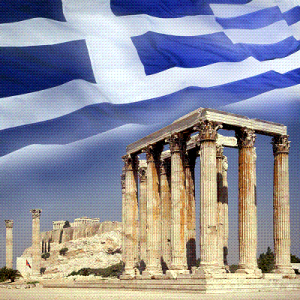 Man kan lugnt säga att ECB har en tuff sommar framför sig med en potentiell Grexit men också sämre utsikter för bland annat Spanien och Italien.
Man kan lugnt säga att ECB har en tuff sommar framför sig med en potentiell Grexit men också sämre utsikter för bland annat Spanien och Italien.
‘Att ECB måste trycka nya pengar är nog inte en dålig gissning, något som kommer att kunna straffa euron och som i sin tur kommer att påverka råvarorna.
En svagare euro kontra dollarna har historiskt sett en negativ påverkan på bland annat ädelmetallerna guld och silver. Många kommer säkert ihåg förra årets skriverier om USAs dåliga ekonomi som fick dollarna att falla och guldet att klättra upp till nivåer kring 1900$/oz. Nu ser vi det omvända.
Den europeiska krisen har till och med fått de allra mest pessimistiska att tro på en EUR/USD kurs kring 1.00 (nu kring 1.25). Det är alltså ingen dålig gissning att guld kan falla om EUR/USD också faller. Som bilden nedan visar har Guld haft en stark koppling till EUR/USD den senaste tiden.
Detta grundar sig i att om dollarn blir starkare jämfört med andra valutor blir guld dyrt att investera i för utländska investerare. Självklart är det så att är många fler faktorer än dollarkursen som styr guldpriset men jag kommer i alla fall hålla koll på kursen den närmaste tiden.
Råvaror – Energi
Brent olja
- Brentoljan är nu för första gången i år nere på negativa siffror. Drygt 3% ned för året.
- Under maj månad har Brent-oljan tappat nästan 13%.
- En viktig faktor är den stärkta dollarn kontra andra valutor vilket pressar priset på oljan.
- Rekordhöga lagernivåer driver ned priset. Oroligheterna i mellanöstern som drev upp oljepriset i början av året verkar nu vara utraderade.
- Säljare av olja blir fler och fler vilket i kombination av en stärkt dollar och höga lagernivåer kan tala för ett fortsatt fall i oljepriset. $100 är en viktig nivå.
Naturgas
- Naturgas fortsätter att stiga. Under maj månad har naturgas stigit ytterligare 5%.
- Under april-maj har priset på naturgas ökat med nästan 14%.
- För året är dock naturgas ned drygt 20%.
- Lagren av naturgas väntas öka under 2012 med 26 %.
- Trots stora naturgaslager ökar priset på naturgas vilket dels kan förklaras av att temperaturen i USA spås ligga under det normala i juni och juli.
Råvaror – Metaller
Guld
- Guld fortsätter att tappa under maj. Under maj månad är guld ned ca. 6%.
- Sedan i slutet av februari har guld tappat drygt 12% och ligger nu +-0 för året.
- Reuters publicerade i april sin guldundersökning. Där förutspås en guldkurs som fluktuerar i ett stort spann men som ligger något över dagens nivåer vid årets slut.
- En starkare dollar kontra andra valutor, med euron i spetsen, bidrar till kräftgången i guldpriset.
- Olika centralbanker med Mexiko, Ryssland och Sydkorea i spetsen köpte under 2011/2012 455 ton guld. Det största inköpet sedan 1964.
Silver
- Silvers kraftiga uppgång under jan-feb raderades under maj månad.
- Efter en nedgång på över 10% i maj är nu silver +-0 för året.
- Silverproduktionen väntas öka 4% under 2012.
- Överskottet av silver väntas i slutet av 2012 bli smått otroliga 5060 ton.
- Den europiska kreditkrisen i kombination med rädsla för minskad kinesisk tillväxt bidrar till de negativa sentimenten i silver.
- Att dollarn stärkts mot euron bidrar även till den fallande trenden.
Platina
- Likt de andra ädelmetallerna är platina ned under maj månad. Nedgången stannade vid knappa 11%.
- För året är platina upp knappa 2%.
- Platina fortsätter at handlas till en billigare kurs än guld. Analytikerna spår dock att platina kommer vara den dyrare av de två vid slutet av året.
- Den starka dollarn sätter även här käpparna i hjulet på platinapriset.
- Efter strejken vid Rustenburggruvan i Sydafrika ökar nu lagren av platina samtidigt som efterfrågan minskar.
Koppar
- Kan tyckas tjatigt men även koppar tappade under maj månad. Nedgången med nästan 14% raderar ut hela årets uppgång.
- Kopparinventarierna ligger på låga nivåer och lagren av koppar räcker endast i tre veckor.
- Samma siffra väntas sjunka till 2.8 under 2013 vilket kan trycka upp kopparpriset ytterligare.
- Den största risken ligger i att Kina, med 40% av världskonsumtionen, står inför en minskande tillväxt.
Zink
- Den tunga månaden för metaller gäller även för zink. Zink är under maj månad ned ca. 8%. För året är zink upp drygt 3,5%.
- Zinklagrena är mer än fulla vilket kan komma att pressa priset ytterligare.
- Kina är återigen en viktig bricka i spelet. En minskad tillväxt i Kina kommer troligtvis ha en betydande effekt på zinkpriset. Kina står för 43% av världens konsumtion.
- Det uppskattas att nuvarande zinktillgång skulle räcka 9,1 veckor, 2,6 veckor längre än 2011.
Nickel
- Nickel presterade sämst av alla basmetaller under 2011.
- Nickel fortsätter sin kräftgång under 2012. I maj backade nickel över 8% och är för året ned nästan 9%.
- Nickelmarknaden är mättad med ökande lager.
- Produktionen väntas överstiga konsumtionen under 2012. Mängden tillgänglig nickel väntas dock minska under 2013 och i kombination med ett bättre marknadsläge spår analytikerna ett högre nickelpris under 2013.
- Nuvarande nickelnivåer räcker för 9,1 veckors konsumtion. Ca en vecka högre än 2011.
Råvaror – Jordbruk
Socker
- Socker startade året starkt, till följd av dåliga och torra väderförhållandena i världens största sockerproducerande land, Brasilien.
- Sedan mars faller dock socker kraftigt. Indien producerar och exporterar socker i hög fart vilket resulterat i att socker under mars-maj tappat nästan 24%.
- I Indien, som öppnat för obegränsad export, spås rekordskördar.
- Genomsnittspositionen är fortsatt lång men säljarna börjar nu bli fler och fler.
Bomull
- Bomull är för året ned ca 26% där merparten av nedgången kom i maj. I maj föll bomullspriset med närmare 20%.
- Rekordexport av bomull från Indien pressar priset.
- Trots att bomullspriset fallit kraftigt under 2012 är det fortfarande nästan dubbelt så högt som priset för några år sedan. Fallhöjden är således stor.
Majs
- Majspriset är under maj månad ned över 14% vilket också motsvarar årsnedgpngen i majs.
- Den kommande skörden vänats vara av mycket god kvalitet.
- För att den negativa trenden i majs ska brytas krävs fortsatt torka i USA. Regnväder är dock att vänta under sommamånaderna.
- Statistik som visar USA-exporten av majs ökar kraftigt. Kina importerar nu rekordstora mängder majs.
Vete
- Vetepriset är under maj månad upp nästan 7% till följd av torra väderförhållanden i USA, Kina och Europa.
- För året är dock vete ned dryga 1%.
- Spekulanterna har under maj månad skiftat tro. Antalet korta positioner har minskat kraftigt.
Apelsinjuice
- Priset på apelsinjuice fortsätter att falla som en sten. Under maj månad är priset apelsinjuice ned 26%.
- Det finns fortfarande fallhöjd i kursen då apelsinjuice har stigit med nästan 70 % sedan 2009.
- Skörden I Florida är mycket god till följd av frostfria väderförhållanden. Samtidigt visar rapporter att efterfrågan på apelsinjuice minskar vilken kyler av priset.
[box]Denna uppdatering är producerat av SIP Nordic och publiceras i samarbete och med tillstånd på Råvarumarknaden.se[/box]
Ansvarsbegränsning
Detta produktblad utgör endast marknadsföring och har sammanställts av SIP Nordic Fondkommission AB.
Innehållet ger inte fullständig information avseende det finansiella instrumentet. Investerare uppmanas att del av prospekt och slutliga villkor, vilka finns tillgängliga på: www.rbsbank.se/markets, innan ett investeringsbeslut tas.
Förekommande exempel är simulerade och baseras på SIP Nordics egna beräkningar och antaganden, en person som använder andra data eller antaganden kan nå andra resultat. Administrativa avgifter och transaktionsavgifter påverkar den faktiska avkastningen.
Analys
Brent crude ticks higher on tension, but market structure stays soft

Brent crude has climbed roughly USD 1.5-2 per barrel since Friday, yet falling USD 0.3 per barrel this mornig and currently trading near USD 67.25/bbl after yesterday’s climb. While the rally reflects short-term geopolitical tension, price action has been choppy, and crude remains locked in a broader range – caught between supply-side pressure and spot resilience.

Prices have been supported by renewed Ukrainian drone strikes targeting Russian infrastructure. Over the weekend, falling debris triggered a fire at the 20mtpa Kirishi refinery, following last week’s attack on the key Primorsk terminal.
Argus estimates that these attacks have halted ish 300 kbl/d of Russian refining capacity in August and September. While the market impact is limited for now, the action signals Kyiv’s growing willingness to disrupt oil flows – supporting a soft geopolitical floor under prices.
The political environment is shifting: the EU is reportedly considering sanctions on Indian and Chinese firms facilitating Russian crude flows, while the U.S. has so far held back – despite Bessent warning that any action from Washington depends on broader European participation. Senator Graham has also publicly criticized NATO members like Slovakia and Hungary for continuing Russian oil imports.
It’s worth noting that China and India remain the two largest buyers of Russian barrels since the invasion of Ukraine. While New Delhi has been hit with 50% secondary tariffs, Beijing has been spared so far.
Still, the broader supply/demand balance leans bearish. Futures markets reflect this: Brent’s prompt spread (gauge of near-term tightness) has narrowed to the current USD 0.42/bl, down from USD 0.96/bl two months ago, pointing to weakening backwardation.
This aligns with expectations for a record surplus in 2026, largely driven by the faster-than-anticipated return of OPEC+ barrels to market. OPEC+ is gathering in Vienna this week to begin revising member production capacity estimates – setting the stage for new output baselines from 2027. The group aims to agree on how to define “maximum sustainable capacity,” with a proposal expected by year-end.
While the IEA pegs OPEC+ capacity at 47.9 million barrels per day, actual output in August was only 42.4 million barrels per day. Disagreements over data and quota fairness (especially from Iraq and Nigeria) have already delayed this process. Angola even quit the group last year after being assigned a lower target than expected. It also remains unclear whether Russia and Iraq can regain earlier output levels due to infrastructure constraints.
Also, macro remains another key driver this week. A 25bp Fed rate cut is widely expected tomorrow (Wednesday), and commodities in general could benefit a potential cut.
Summing up: Brent crude continues to drift sideways, finding near-term support from geopolitics and refining strength. But with surplus building and market structure softening, the upside may remain capped.
Analys
Volatile but going nowhere. Brent crude circles USD 66 as market weighs surplus vs risk

Brent crude is essentially flat on the week, but after a volatile ride. Prices started Monday near USD 65.5/bl, climbed steadily to a mid-week high of USD 67.8/bl on Wednesday evening, before falling sharply – losing about USD 2/bl during Thursday’s session.

Brent is currently trading around USD 65.8/bl, right back where it began. The volatility reflects the market’s ongoing struggle to balance growing surplus risks against persistent geopolitical uncertainty and resilient refined product margins. Thursday’s slide snapped a three-day rally and came largely in response to a string of bearish signals, most notably from the IEA’s updated short-term outlook.
The IEA now projects record global oversupply in 2026, reinforcing concerns flagged earlier by the U.S. EIA, which already sees inventories building this quarter. The forecast comes just days after OPEC+ confirmed it will continue returning idle barrels to the market in October – albeit at a slower pace of +137,000 bl/d. While modest, the move underscores a steady push to reclaim market share and adds to supply-side pressure into year-end.
Thursday’s price drop also followed geopolitical incidences: Israeli airstrikes reportedly targeted Hamas leadership in Doha, while Russian drones crossed into Polish airspace – events that initially sent crude higher as traders covered short positions.
Yet, sentiment remains broadly cautious. Strong refining margins and low inventories at key pricing hubs like Europe continue to support the downside. Chinese stockpiling of discounted Russian barrels and tightness in refined product markets – especially diesel – are also lending support.
On the demand side, the IEA revised up its 2025 global demand growth forecast by 60,000 bl/d to 740,000 bl/d YoY, while leaving 2026 unchanged at 698,000 bl/d. Interestingly, the agency also signaled that its next long-term report could show global oil demand rising through 2050.
Meanwhile, OPEC offered a contrasting view in its latest Monthly Oil Market Report, maintaining expectations for a supply deficit both this year and next, even as its members raise output. The group kept its demand growth estimates for 2025 and 2026 unchanged at 1.29 million bl/d and 1.38 million bl/d, respectively.
We continue to watch whether the bearish supply outlook will outweigh geopolitical risk, and if Brent can continue to find support above USD 65/bl – a level increasingly seen as a soft floor for OPEC+ policy.
Analys
Waiting for the surplus while we worry about Israel and Qatar

Brent crude makes some gains as Israel’s attack on Hamas in Qatar rattles markets. Brent crude spiked to a high of USD 67.38/b yesterday as Israel made a strike on Hamas in Qatar. But it wasn’t able to hold on to that level and only closed up 0.6% in the end at USD 66.39/b. This morning it is starting on the up with a gain of 0.9% at USD 67/b. Still rattled by Israel’s attack on Hamas in Qatar yesterday. Brent is getting some help on the margin this morning with Asian equities higher and copper gaining half a percent. But the dark cloud of surplus ahead is nonetheless hanging over the market with Brent trading two dollar lower than last Tuesday.

Geopolitical risk premiums in oil rarely lasts long unless actual supply disruption kicks in. While Israel’s attack on Hamas in Qatar is shocking, the geopolitical risk lifting crude oil yesterday and this morning is unlikely to last very long as such geopolitical risk premiums usually do not last long unless real disruption kicks in.
US API data yesterday indicated a US crude and product stock build last week of 3.1 mb. The US API last evening released partial US oil inventory data indicating that US crude stocks rose 1.3 mb and middle distillates rose 1.5 mb while gasoline rose 0.3 mb. In total a bit more than 3 mb increase. US crude and product stocks usually rise around 1 mb per week this time of year. So US commercial crude and product stock rose 2 mb over the past week adjusted for the seasonal norm. Official and complete data are due today at 16:30.
A 2 mb/week seasonally adj. US stock build implies a 1 – 1.4 mb/d global surplus if it is persistent. Assume that if the global oil market is running a surplus then some 20% to 30% of that surplus ends up in US commercial inventories. A 2 mb seasonally adjusted inventory build equals 286 kb/d. Divide by 0.2 to 0.3 and we get an implied global surplus of 950 kb/d to 1430 kb/d. A 2 mb/week seasonally adjusted build in US oil inventories is close to noise unless it is a persistent pattern every week.
US IEA STEO oil report: Robust surplus ahead and Brent averaging USD 51/b in 2026. The US EIA yesterday released its monthly STEO oil report. It projected a large and persistent surplus ahead. It estimates a global surplus of 2.2 m/d from September to December this year. A 2.4 mb/d surplus in Q1-26 and an average surplus for 2026 of 1.6 mb/d resulting in an average Brent crude oil price of USD 51/b next year. And that includes an assumption where OPEC crude oil production only averages 27.8 mb/d in 2026 versus 27.0 mb/d in 2024 and 28.6 mb/d in August.
Brent will feel the bear-pressure once US/OECD stocks starts visible build. In the meanwhile the oil market sits waiting for this projected surplus to materialize in US and OECD inventories. Once they visibly starts to build on a consistent basis, then Brent crude will likely quickly lose altitude. And unless some unforeseen supply disruption kicks in, it is bound to happen.
US IEA STEO September report. In total not much different than it was in January

US IEA STEO September report. US crude oil production contracting in 2026, but NGLs still growing. Close to zero net liquids growth in total.

-

 Nyheter4 veckor sedan
Nyheter4 veckor sedanMeta bygger ett AI-datacenter på 5 GW och 2,25 GW gaskraftverk
-

 Nyheter4 veckor sedan
Nyheter4 veckor sedanAker BP gör ett av Norges största oljefynd på ett decennium, stärker resurserna i Yggdrasilområdet
-

 Nyheter4 veckor sedan
Nyheter4 veckor sedanSommarens torka kan ge högre elpriser i höst
-

 Analys4 veckor sedan
Analys4 veckor sedanBrent edges higher as India–Russia oil trade draws U.S. ire and Powell takes the stage at Jackson Hole
-

 Nyheter3 veckor sedan
Nyheter3 veckor sedanMahvie Minerals är verksamt i guldrikt område i Finland
-

 Analys3 veckor sedan
Analys3 veckor sedanIncreasing risk that OPEC+ will unwind the last 1.65 mb/d of cuts when they meet on 7 September
-

 Nyheter3 veckor sedan
Nyheter3 veckor sedanNeil Atkinson spår att priset på olja kommer att stiga till 70 USD
-

 Analys2 veckor sedan
Analys2 veckor sedanOPEC+ in a process of retaking market share


